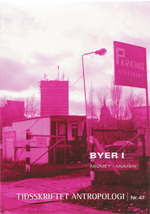ABOMEY
DOI:
https://doi.org/10.7146/ta.v0i47.107108Abstract
The West African city Abomey was the
centre of the kingdom Dahomey, notorious
for its slave raids, ritual sacrifices of
human beings, and its religious belief in
vodhuns. Today a peaceful town in the
state of Benin, its visual non-citylike
impression provides the outset for reflections
on what constitutes a city. The article
digs into the history of the kingdom of
Dahomey and relates how it was constructed
on the basis of expansion and
incorporation of its enemies through
assimilation, but also symbolically expressed
in rituals that celebrated the
conquest of the enemies. Such stories are
recounted today in the historical royal
palace, the Musée Historique d’Abomey,
where the famous bas-reliefs and the
stories of how the kings’ palaces were built
on the blood of the enemies testify to the
historical drama of the kingdom. The
article compares today’s city of Abomey
with the neighbouring city of Bohicon,
which at first glance seems to live up to
expected standards of what constitutes a
modern city much better than does
Abomey. However, it is argued that commerce,
exchange, heterogeneity and traffic
are not enough to constitute a city. Historically,
Abomey had an aura of holiness
to it, which sprang from its placement at
the centre of the kingdom, but also from
its being the frame for the temples of the
gods and the king. This gives rise to a
question of what kind of holiness can be
attributed to modern cities. If they are not
“holy” by virtue of being cities of kings
or historical centres, cities will have to
create themselves for instance through
performative culture and historical
recreation.
Downloads
Published
How to Cite
Issue
Section
License
Ophavsretten til artiklerne i Tidsskriftet Antropologi tilfalder forfatteren.
Artikler publiceret i Tidsskriftet Antropologi må citeres, downloades og videresendes for ikke-kommerciel brug, under forudsætning af normal akademisk reference til forfatter(e) samt tidsskrift, årgang, nummer og sider. Artiklerne må kun genudgives med eksplicit tilladelse fra forfatter(e) og tidsskriftet.


